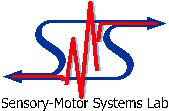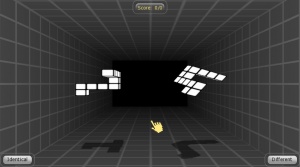Difference between revisions of "Addressing Patient Motivation In Virtual Reality Based Neurocognitive Rehabilitation"
(→The System Prototype that was created) |
(→The System Prototype that was created) |
||
| Line 61: | Line 61: | ||
[http://mmi.tudelft.nl/vret_oud/images/6/68/S1367803_progress_presentation_5_feb_2010.pdf] In this second progress presentation the focus is on showing the software as it has been developed so far, and obtain feedback on it. | [http://mmi.tudelft.nl/vret_oud/images/6/68/S1367803_progress_presentation_5_feb_2010.pdf] In this second progress presentation the focus is on showing the software as it has been developed so far, and obtain feedback on it. | ||
| − | == The System Prototype | + | == The System Prototype == |
During the course of this project a system prototype has been created. The virtual training and assessment environments are presented to the patient using a consumer grade computer attached to a TV screen, while gesture based input and tactile output is also possible using a Wii Remote as a pointing and selection device. The orientation and position of a user's head will also be tracked using cheap consumer grade hardware. This creates a novel setup in which any TV is transformed into a holographic surface, and can act as a catalyst for user motivation and engagement with any virtual environment that is presented. | During the course of this project a system prototype has been created. The virtual training and assessment environments are presented to the patient using a consumer grade computer attached to a TV screen, while gesture based input and tactile output is also possible using a Wii Remote as a pointing and selection device. The orientation and position of a user's head will also be tracked using cheap consumer grade hardware. This creates a novel setup in which any TV is transformed into a holographic surface, and can act as a catalyst for user motivation and engagement with any virtual environment that is presented. | ||
| Line 83: | Line 83: | ||
Here is a video which shows the system prototype used during the pilot study, in a simulated living room environment: | Here is a video which shows the system prototype used during the pilot study, in a simulated living room environment: | ||
| − | + | [http://www.youtube.com/watch?v=uIfzAiN2Z-M]. | |
| − | |||
| − | |||
| − | |||
== Involved Members == | == Involved Members == | ||
*[[User:Panics|Sacha Panic]] | *[[User:Panics|Sacha Panic]] | ||
Revision as of 13:50, 18 August 2010
Thesis title: Addressing Patient Motivation in Virtual Reality Based Neurocognitive Rehabilitation
Degree: Master of Science in Media & Knowledge Engineering
Department/Group: Mediamatics/Man Machine Interaction
Author: Alexander Sacha Panic
Student number: 1367803
Date: August, 2010
Examination Committee: Prof. Dr. M. Neerincx, Dr. Ir. W.P. Brinkman, Drs. P.R. van Nieuwenhuijzen
Contents
Abstract
Cognitive rehabilitation exercises are typically not designed to be motivating. The use of virtual reality and gaming technology can help with increasing the patient’s motivation and adherence. A physically active gaming experience leads to an increased adherence and affective attitude and an increased incentive to engage with healthy behavior. A psychological perspective on player motivation allows game design to explicitly focus on motivational variables, while affective gaming mechanisms allow games to infer the player’s affective state and change their content accordingly.
This research project investigated if neurocognitive rehabilitation exercises based on affective gaming and physically active interaction lead to an increase in motivation of elderly people, while improving their cognitive skills. Part of this project was carried out at the Sensory-Motor Systems (SMS) lab , under supervision of the lab’s director Prof. Dr. –Ing. R. Riener. The SMS lab is associated to the Swiss Federal Institute of Technology in Zürich, and the University Hospital Balgrist, Medical Faculty, University of Zürich, Switzerland. The goal of this project presented has been to develop and evaluate the hypotheses, methodology, and system prototype to enable the SMS lab to conduct a clinical experiment which investigates patient motivation in virtual reality based neurocognitive rehabilitation.
An affective gaming based training and assessment environment for the mental rotation task was used in a pilot study with 9 able-bodied and healthy participants aged 55 to 80. The results support the hypothesis that use of affective game design elements (e.g. incorporation of high scores, achievement medals, adaptive difficulty, different game modes and offering affective feedback) is motivating to the elderly population to engage with rehabilitation exercises. The results also support the hypothesis that a physically active gaming experience (provided by e.g. embodied interaction mechanisms) is motivating to the elderly. However more data is needed for the results to be more conclusive.
Project collaborators
 This thesis includes project work done at ETH Zurich [1] |
 The IDEA league [4] provided financial support for my stay abroad |
Project status
Research project: finished.
Thesis project: finished.
Thesis defense: being scheduled...
Downloads
November 10th, 2009 - Literature research (draft): [5] A draft version of the literature research into the topics 'cognition and neurocognitive rehabilitation', 'virtual reality based neurocognitive rehabilitation' and 'affect, learning and games'
December 7th, 2009 - Intermediate project presentation: [6] These powerpoint slides were used during an intermediate presentation of the project and its progress so far. The presentation will be given at the ETH on December 7th, and has also been given in a lecture Man Machine Systems at the DUT (3mE). The powerpoint contains clickable links to introductory papers that were published on related topics, as well as additional (requested) background information (e.g. presentations on TED and Discovery channel about brain plasticity and cognitive reserve)
February 1st, 2010 - Study proposal for the ETH ethics committee:
[7]
In Switzerland it is prohibited by law to conduct experiments using human participants without an approval by an ethics committee. This is regardless of the medical status of the participants (healthy or diagnosed with a medical condition). In the Netherlands there is something similar: the 'wet medisch wetenschappelijk onderzoek' [8], see also the website of 'Centrale Commissie Mensgebonden Onderzoek' [9].
This proposal details the study goals, design and protocol to be carried out by the project collaborators from the SMS lab. In this study the protocol, questionnaires and software used will be verified and calibrated using healthy participants (age 45-70). The study is expected to take place from approximately March 22nd to June 7th 2010. However this depends on approval of the proposal by the ETH ethics committee. This study will then be repeated in a followup (clinical) study with participants diagnosed with mild cognitive impairments due to Alzheimer's Disease. However since the followup study targets the clinical population, this will require approval by another (kantonal or regional) ethics committee.
February 5th, 2010 - Presentation of designed study and software development work in progress:
[10] In this second progress presentation the focus is on showing the software as it has been developed so far, and obtain feedback on it.
The System Prototype
During the course of this project a system prototype has been created. The virtual training and assessment environments are presented to the patient using a consumer grade computer attached to a TV screen, while gesture based input and tactile output is also possible using a Wii Remote as a pointing and selection device. The orientation and position of a user's head will also be tracked using cheap consumer grade hardware. This creates a novel setup in which any TV is transformed into a holographic surface, and can act as a catalyst for user motivation and engagement with any virtual environment that is presented.
|
|
The software also records performance related data, and outputs this in several file formats (XML, CSV) which are understandable by statistical analysis software. See for instance this example [11].
Here is a video which shows the system prototype used during the pilot study, in a simulated living room environment:
[12].



